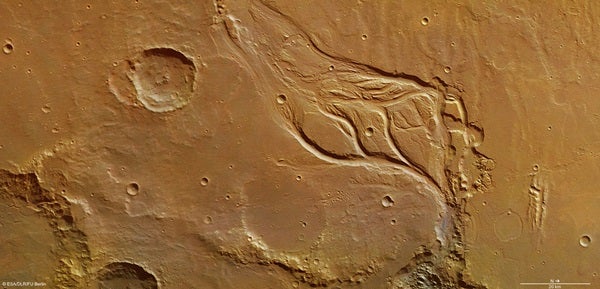Images captured December 7, 2013, by the European Space Agency’s (ESA) Mars Express show the central portion of Osuga Valles, which has a total length of 102 miles (164 kilometers). It is some 105 miles (170km) south of Eos Chaos, which lies in the far eastern section of Valles Marineris.
Osuga Valles is an outflow channel that emanates from a region of chaotic terrain at the edge of Eos Chaos to the west (top of image). Such landscape is dominated by randomly oriented and heavily eroded blocks of terrain. Another example is seen at the bottom of this scene, filling the 1.5-mile-deep (2.5km) depression into which Osuga Valles empties.
Catastrophic flooding is thought to have created the heavily eroded Osuga Valles and the features within it. Streamlines around the islands in the valley indicate that the direction of flow was toward the northeast, and sets of parallel, narrow grooves on the floor of the channel suggest that the water was fast flowing.
Differences in elevation within the feature, along with the presence and cross-cutting relationships of channels carved onto the islands, suggest that Osuga Valles experienced several episodes of flooding.
Close to the northernmost (far right of image) part of the channel, two large irregular-shaped blocks appear to have broken away from the surrounding terrain but do not seem to have experienced as much erosion as the rounded islands.
The floodwater eventually emptied into the deep depression of chaotic terrain at the bottom of the main images, but it is not yet known whether the water drained away into the subsurface or formed a temporary lake.










